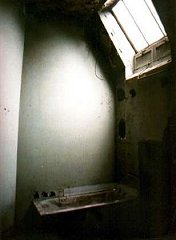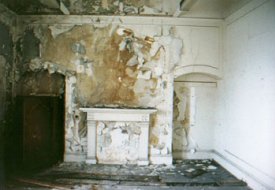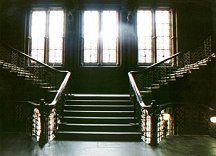Altered images
Marc Evans'
psychological
thriller Trauma, starring Colin Firth, has found a perfect home in the
Gothic vaults of St Pancras Chambers. The director and star tell Mark
Salisbury how the location affected their vision
|

|
As spooky locations go, St Pancras
Chambers is among the spookiest. With its vaulted ceilings, peeling
wallpaper, long, dim corridors and dank basement, the Victorian Gothic
building—once the Midland Grand hotel, now Grade
I-listed—reeks of must and menace. A perfect
place, in other words, to film a psychological horror chiller such as
Trauma.
Which is why, on a cold morning last June, Colin Firth is skulking the
building's corridors looking more like a tramp than the heartthrob that
Pride and Prejudice made him. Dressed in scruffy jeans and jacket, he
looks dishevelled and downbeat, playing a character who believes he is
haunted by visions of his dead wife (Naomie Harris) who died in the car
crash that he survived. He may also be a murderer, responsible for the
death of a pop star whose body was found washed up in an east London
canal.
 Equal parts Don't Look Now, Jacob's Ladder and
Patrick McGrath's Spider, Trauma revolves around Firth's grief-stricken
coma survivor who, attempting to get on with his life, moves into a
flat in a converted hospital and is soon befriended by a neighbour,
Charlotte (Mena Suvari from Americans Pie and Beauty), who is into
crystals and all things spiritual, and who tries to help Ben find some
peace. But as his tenuous grip on reality starts to loosen, we are left
wondering not only about Ben's mental wellbeing, but whether the
ethereal Charlotte may be another figment of his disturbed imagination. Equal parts Don't Look Now, Jacob's Ladder and
Patrick McGrath's Spider, Trauma revolves around Firth's grief-stricken
coma survivor who, attempting to get on with his life, moves into a
flat in a converted hospital and is soon befriended by a neighbour,
Charlotte (Mena Suvari from Americans Pie and Beauty), who is into
crystals and all things spiritual, and who tries to help Ben find some
peace. But as his tenuous grip on reality starts to loosen, we are left
wondering not only about Ben's mental wellbeing, but whether the
ethereal Charlotte may be another figment of his disturbed imagination.
"The beginning of the film is about grief, then changes to being a film
about madness," says Trauma director Marc Evans, who helped start a
mini-revival in British horror cinema with his last film, the inventive
thriller My Little Eye. "It's about loneliness, about someone whose
grief kind of leads them to a kind of madness and a warped perception
of the world."
As the first film to emerge from The Ministry of Fear, the production
company headed by former Edinburgh Film Festival director Lizzie
Frankie, and devoted exclusively to horror—whose slate includes projects penned by
Muriel Gray and novelist Kim Newman—many eyes are on Trauma to see whether
it can deliver. Yet Evans doesn't see Trauma as being a horror movie
per se. "It's definitely in the zone of grown-up psychological
thriller," he says. "It's a film that takes itself seriously. It's not
ironic. It doesn't play jokes with an audience. It starts with a
concept: what if you lost your wife and you woke up on the day that the
world was grieving for a Princess Di or Jill Dando, some kind of
celebrity grief phenomenon?"
"It is
much more about mind games and paranoia and what might be frightening
and what might be menacing," says Firth, during a break in filming.
"There will be a bit of boo as well. It's unashamedly trying to mess
with your mind a bit."
So how does Firth go about playing a man who is not in control of his
senses? "If you're playing a character who can't distinguish reality
from fantasy, you have to use your judgment," he explains. "If
something seems real to you, you have to play it as if it's real. So in
some ways it's perfectly simple. He thinks his wife's dead and then he
sees her; thinks maybe she's alive, but he's not sure. You have to
think yourself into that situation; it can be a fairly freaky thing.
You certainly can't play a thing called madness, because nobody thinks
they're mad."
To help realise Trauma's altered sense of perception, and to drive home
the sense of unease, Evans was keen to use odd, unsettling locations
and show a view of London that hadn't been seen of film before. "We
were trying to create a certain idea of Canary Wharf and the City as
this kind of malign, faceless modern East End, and then below that this
kind of Gothic, almost Victorian place where Ben might live. The idea
is he moved into a flat in a converted hospital, and maybe in a strange
way he's never left the hospital during the whole film." Such a place
initially proved difficult to find. "We found a lot of interesting
interiors but I kept feeling we didn't have the scale of, say, the
Dakota Building in Rosemary's Baby."
 Evans
eventually found what he was after in one of London's most well known
landmarks—St Pancras Chambers. As the Midland
Grand hotel, which opened in 1876, it had been famed for its then
innovative features, among them its hydraulic, ascending chambers and
revolving doors. Closed as a hotel in 1935, it remained in use as
offices until the 60s when it was listed and saved from demolition,
although it lost its fire certificate in the 80s and has been empty
ever since. Although the exterior was renovated in the mid-90s, the
interior has been seriously neglected - and this has proved popular
with filmmakers, with The Madness Of King George, Richard III and even
the Spice Girls' Wannabe video among those having filmed inside. For
Evans it provided the perfect architectural feature for his film. "We
wanted a really long corridor because all films about people going mad
have got long corridors in them," he laughs. "There's one upstairs 250
feet long." Evans
eventually found what he was after in one of London's most well known
landmarks—St Pancras Chambers. As the Midland
Grand hotel, which opened in 1876, it had been famed for its then
innovative features, among them its hydraulic, ascending chambers and
revolving doors. Closed as a hotel in 1935, it remained in use as
offices until the 60s when it was listed and saved from demolition,
although it lost its fire certificate in the 80s and has been empty
ever since. Although the exterior was renovated in the mid-90s, the
interior has been seriously neglected - and this has proved popular
with filmmakers, with The Madness Of King George, Richard III and even
the Spice Girls' Wannabe video among those having filmed inside. For
Evans it provided the perfect architectural feature for his film. "We
wanted a really long corridor because all films about people going mad
have got long corridors in them," he laughs. "There's one upstairs 250
feet long."
 According
to Firth, the building is more than simply a visual metaphor for his
character's descent into madness: its unsettling ambience has even
seeped into his performance. "It's doing all the work today as far as
I'm concerned," he says. "It looks paranoiac, if you light it right. So
in many ways these are my days off. It's very rare that as an actor,
you get any of the stimuli that your character would get, but they've
managed to make the atmosphere so creepy at times." According
to Firth, the building is more than simply a visual metaphor for his
character's descent into madness: its unsettling ambience has even
seeped into his performance. "It's doing all the work today as far as
I'm concerned," he says. "It looks paranoiac, if you light it right. So
in many ways these are my days off. It's very rare that as an actor,
you get any of the stimuli that your character would get, but they've
managed to make the atmosphere so creepy at times."
The
building was always been one of his favourites, Firth admits. "I'd been
dying to get inside. It kind of surpasses expectations because it is
just as kind of gloomy and ghostly as I'd hoped it would be, but is
also more magnificent than I imagined. You can see squares where nasty
paint has been taken off and underneath there's a piece of
extraordinary Edwardian wallpaper." Of plans to renovate the building
as a luxury hotel, he says: "In a way it's almost a pity to do anything
with it. It feels like what it must be like if you could go down on the
Titanic."
 For
Firth, Trauma was an opportunity not only to work with Evans again—the pair previously collaborated on the
1994 Ruth Rendell TV adaptation Master Of The Moor—but to shed the labels of period and
romantic comedy, for which he has become synonymous for a while. "It's
the kind of film I love to go and see, and I haven't spent a lot of
time doing the kind of films I love to go and see," he reflects. "There
have been a lot of romantic comedies made, and a lot have come my way,
but I never go to them. This is something that interests me. It
reminded me a little bit of some of the paranoia films that I liked in
the 70s, some of the Polanski films, and things like Don't Look Now." For
Firth, Trauma was an opportunity not only to work with Evans again—the pair previously collaborated on the
1994 Ruth Rendell TV adaptation Master Of The Moor—but to shed the labels of period and
romantic comedy, for which he has become synonymous for a while. "It's
the kind of film I love to go and see, and I haven't spent a lot of
time doing the kind of films I love to go and see," he reflects. "There
have been a lot of romantic comedies made, and a lot have come my way,
but I never go to them. This is something that interests me. It
reminded me a little bit of some of the paranoia films that I liked in
the 70s, some of the Polanski films, and things like Don't Look Now."
Like his star Evans acknowledges the shadow that Don't Look Now, the
Nicolas Roeg classic, casts over Trauma. Both films deal with the
supernatural and the effects of grief. Both films trade in Gothic
menace, a fractured narrative, the use of fragments of colour and
cracked imagery to shock and dislocate. Both films rest on the
reliability of the narrator. But one is a certified classic and the
other is only released this month.
"It's almost as unhelpful as it is helpful to have a film that good as
an influence, but it definitely inspires, to be in that territory,"
Evans says. "I've kind of made myself a rule of never invoking other
directors because you're never going to be as good as them necessarily.
Having said that, it's very hard to have a conversation about genre
films without talking about other genre films. That's the difference
between them and art movies. No self-respecting art moviemaker would
say they were trying to make a Tarkovsky film. Inevitably there are
connections between genre films and there's a kind of British tradition
you can aspire to, [which] Roeg represents par excellence."
It was Evans' unfamiliarity with the genre that made My Little Eye so
refreshing, as he brought an unsullied perspective to a well-worn
formula, and made himself something of a star in the horror field as a
result. So even if Evans doesn't see Trauma as a horror film, that is
how it is going to be perceived. Is he comfortable being pigeonholed as
a horror director?
"What I'm comfortable with is being allowed to work," he says with a
wide grin. "After House [Of America] and Resurrection Man I literally
couldn't get arrested. I'd committed some crimes against filmmaking, as
perceived by financiers; I had made films that were dark and didn't
make any money. The great thing about genre filmmaking is that for
someone like me who's not interested in social realism or social
comedy, it's probably one of the places I could exist and be employed,
because it requires imagination and intelligence and to play with ideas
in a cinematic way. Financiers don't look at you askance because you've
gone a bit weird on them. They want you to be weird. If that could be
my only resting place, I'd be happy with that. If that meant I could
make a film a year, I'd be very happy with that."
|

 Equal parts Don't Look Now, Jacob's Ladder and
Patrick McGrath's Spider, Trauma revolves around Firth's grief-stricken
coma survivor who, attempting to get on with his life, moves into a
flat in a converted hospital and is soon befriended by a neighbour,
Charlotte (Mena Suvari from Americans Pie and Beauty), who is into
crystals and all things spiritual, and who tries to help Ben find some
peace. But as his tenuous grip on reality starts to loosen, we are left
wondering not only about Ben's mental wellbeing, but whether the
ethereal Charlotte may be another figment of his disturbed imagination.
Equal parts Don't Look Now, Jacob's Ladder and
Patrick McGrath's Spider, Trauma revolves around Firth's grief-stricken
coma survivor who, attempting to get on with his life, moves into a
flat in a converted hospital and is soon befriended by a neighbour,
Charlotte (Mena Suvari from Americans Pie and Beauty), who is into
crystals and all things spiritual, and who tries to help Ben find some
peace. But as his tenuous grip on reality starts to loosen, we are left
wondering not only about Ben's mental wellbeing, but whether the
ethereal Charlotte may be another figment of his disturbed imagination.

 For
Firth, Trauma was an opportunity not only to work with Evans again
For
Firth, Trauma was an opportunity not only to work with Evans again